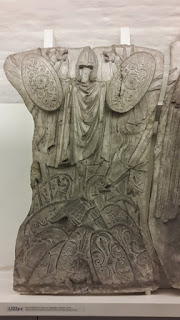The Alexander frieze created in 1812. The original is 35 m long and 1 m high. The copy on display in the museum is smaller than the original.
The left side of the frieze: civilians (with animals) come out to meet Alexander when he is about to enter Babylon.
Civilians with animals greeting Alexander.
Civilians with animals.
The civilian procession.
Civilians come out to greet Alexander and his army.
The civilians from Babylon meet with Alexander who is riding in his chariot.
The central panel of the frieze: Alexander in his chariot.
The right side of the frieze: Alexander (in his chariot) leading his army.
Alexander's army: the cavalry (1).
Alexander's army: the cavalry (2).
Alexander's army: the cavalry (3).
Alexander's army: the infantry and an elephant.
The end of the frieze.
At the very end of the frieze - next to a palm tree - Thorvaldsen has placed himself!
Detail of the civilian procession: four persons and a camel.
Detail of the left side of the frieze: three men are escaping across the river Euphrates in a small boat. There is an element of danger here.
Detail of the civilian procession: a horse and two lions.
Detail of the civilian procession: musicians greeting Alexander and his army.
Detail of Alexander's army (the right side of the frieze): the cavalry.
Detail of Alexander's army: the infantry with an elephant.
Ludvig Holberg (1684-1754).
Thorvaldsen was not only an artist who created great sculptures. He was also a collector. During his long stay in Italy, he collected numerous objects from ancient Egypt, ancient Greece, and ancient Rome. Sometimes he would make a plaster cast of an ancient object. This item is a plaster cast of the Egyptian Pharaoh Menerphta II (1236-1223 BC).
A plaster cast of Egyptian Pharaoh Amenhotep (Amenophis) III (1417-1379 BC).
A cabinet with ancient objects.
Two cabinets with ancient objects and old books.
The ceiling is decorated with golden stars.
Roman Emperor Marcus Aurelius (161-180). A plaster cast after an ancient portrait.
Roman Emperor Lucius Verus (161-169). Co-emperor with Marcus Aurelius. A plaster cast.
A monochrome mosaic.
The labours of Hercules (1).
The labours of Hercules (2).
The labours of Hercules (3).
A cabinet with ceramics from ancient Greece.
A cabinet with objects from ancient Greece.
Plaster casts in the basement of the museum.
The Greek poet Homer.
Antinous as an Egyptian pharaoh.
Antinous as a Roman hero.
Antinous as a Greek hero.
A scene from Trajan's Column in Rome: the goddess of victory flanked by two trophies.
The trophy on the left side.
The goddess of victory is writing about the Dacian war on the shield.
The trophy on the right side.
The supreme god: Jupiter (in the Roman world) or Zeus (in the Greek world).
Roman Emperor Caracalla (211-217).
Caracalla, son of Lucius Septimius Severus.
* * *
For more information, you can visit the official website of the museum:
Thorvaldsen's Museum in Copenhagen
* * *
















































No comments:
Post a Comment